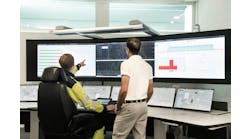If there’s one not-to-be-missed presentation at any European HUG event, then it has to be Jean-Marie Alliet’s Technology Update, not least because it’s one of the very few for which the PowerPoint is not made available either to attendees or to the press. Miss that, and you’ve pretty much wasted the time and effort spent in attending; catch it and, provided you can read the notes you’ve taken at breakneck speed to keep up with his torrential delivery, you can spend the rest of your time researching the bars and cafes of Berlin, Seville, Salzburg or, next year, Lisbon.
Fortified by a last cigarette, indeed given that he started 15 minutes late, probably by half a dozen last cigarettes, Alliet ranged across the entire Honeywell portfolio, hardly drawing breath for 90 minutes and keeping the attention of his audience despite encroaching deep into that most sacrosanct of conference―and indeed Belgian―institutions, lunch. No wonder that, when on the following day, the proceedings began with a dramatized presentation on the wonders of wireless, it was Jean-Marie, alone of the dramatis personae in the one act play, who was cast as himself.
“Standards ready”
Honeywell’s big claim, reiterated by Jack Bolick when he talked to INSIDER later in the day, is that “We don’t leave anyone behind.” Thus OneWireless was described by Alliet as “standards ready,” which means that once the “imminent” ISA100 standard becomes available existing OneWireless users will be able to upgrade their entire network infrastructure “over the air.”
That same theme recurred throughout Alliet’s presentation, not least when he reminded his audience that this year marks the 25th anniversary of TDC 3000 and suggested they consider “Where are the other competitors in their product life cycle?” And it’s an issue which will be in the forefront of users’ minds come 2010 when Honeywell plans the next major release of Experion PKS. Experion R400 will not only add support for Windows Vista and Windows Server 2008, but also will see Experion and TPS “merge completely into one system.”
Before that, however, comes the next intermediate release of Experion, R 310, which includes a number of its own significant developments. Arguably, the most important of these is a new level of integration between the latest release of the Safety Manager Safety Instrumented System (SIS) controller with Experion’s C300 controller over Fault- Tolerant Ethernet. That allows peer-to-peer communication of data between the SIS and BPCS (Basic Process Control System), health monitoring of the safety system components and partial-stroke testing of valves from the BPCS and the implementation of a common HMI for both the SIS and the BPCS. As such, it represents the latest stage of Honeywell’s policy of providing a common look and feel a cross the entire portfolio, based on the Experion HMI with displays derived from the work of the Abnormal Situation Management (ASM) consortium.
Honeywell has still not gone as far down the integrated safety system path as, for example, ABB or Yokogawa in that it uses separate hardware platforms for safety and control systems but it’s clear that both it and the majority of its users are now firmly positioned on the integration side of the argument. Indeed Kees Kemps, director, sales with Honeywell’s Hertogenbosch, Netherlands, operation, sees no technical or philosophical objection to the eventual migration of the SIS on to a common hardware platform, presumably based on the C300 controller. In the meantime, the current release includes expansion of Safety Manager’s coverage to include fire and gas and the implementation of peer-to-peer communications between Safety Managers over SafeNET. Further developments in the offing include new remote I/O for Safety Manager and support for Foundation fieldbus SIS.
Redundant batching
Meanwhile the current release of Experion includes enhanced batch capabilities and additional options for communication with third-party equipment. Batch execution can now run on the fully redundant C300 controller from the same integrated HMI, giving both added protection and faster execution and a claimed reduction of as much as 80% in phase transition times. Further down the road is the promise of additional enhancements to deal with class-based recipes.
On the communications front a new Peer Control Data Interface (PCDI) allows C300 controllers to communicate over Fault-Tolerant Ethernet with devices that talk Modbus TCP, while longer-term plans include a Series C Profibus DP interface module that will again integrate subsystems at the controller level. Any fears that such external interfaces could compromise security are allayed by the introduction of a new Modbus firewall, based on the MTL-Byres Security Tofino.
Also new in the current release is the ability to simulate C300 controllers in a PC environment and, hence, test configurations off-line, enhanced alarming capabilities including shelving of non-critical alarms and the introduction of additional power generation-related capabilities, including new C300 function blocks.



